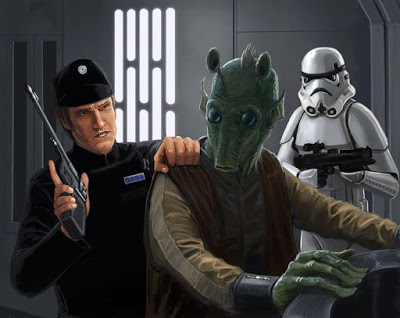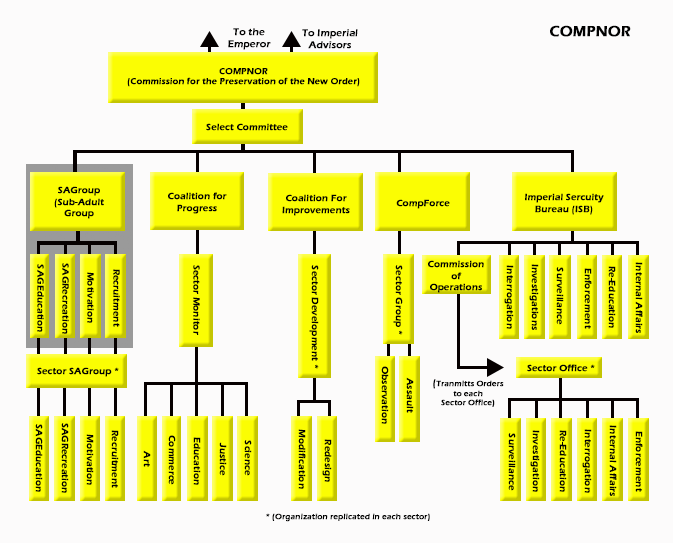
COMPNOR
COMPNOR, the Commission for the Preservation of the New Order, was formed in Imperial City months after Palpatine assumed power. Initially COMPNOR was little more than a social gathering for idealistic young beings who saw in the New Order a deliverance from the chaos of the dying days of the Old Republic.
One of the Emperor’s advisors, one Crueya Vandron, saw the potential worth of a populist movement which could be molded into a useful political tool. Overt encouragement and discrete funding were provided, giving COMPNOR the appearance of a spontaneous organization enjoying phenomenal growth.

Crueya Vandron gave COMPNOR the resources to grow, but the Emperor took a hand in the shaping of the organization. His methods were patient, defeating his opponents within COMPNOR not through violence or threats, but with a hidden, gentle, consistent pressure which wore the opposition down. Those who opposed the change in COMPNOR never even knew the Emperor had done anything to instigate the changes. Most could not even explain how the nature of their organization differed from what they had envisioned.
Key members of the group were approved for the Select Committee, that part of COMPNOR that would oversee the rest of the organization, with implicit approval of the Emperor. Then the changes became more sweeping. The Emperor’s peculiar genius was again demonstrated — he had succeeded in having his enemies unknowingly choose exactly the course of action he desired them to choose.
COMPNOR is no longer an innocuous social club. It has become a powerful tool for the New Order. COMPNOR actively attempts to build the ethic of the New Order into the life of the average galactic citizen. COMPNOR is also recruiting young beings in huge numbers in order to assure that future citizens will consider the Old Republic a relic of the past, committing their lives totally to the New Order.
COMPNORs Role in the Empire
COMPNOR is more than a vocal and enthusiastic group committed to raising young Imperial citizens to be totally loyal to the Empire. COMPNOR has made great pains to recruit from or insert members into the massive Imperial bureaucracy. In time, COMPNOR’s influence became so pervasive that the Imperial bureaucracy was under its complete control, and thus absolutely dedicated to the whims of the Emperor. During that era, the bureaucracy answered to the Imperial Senate (in theory). COMPNOR also took great pains to insert its members into local bureaucracies, on the sector, system, planetary, and even city level.
After Palpatine dissolved the Senate (“for the duration of the emergency”), COMPNOR’s Select Committee was more than adequately prepared to fill the void, directing virtually every policy decision made by the bureaucracy. The regional Moffs and governors had control over their systems, but also know that they will be observed by countless COMPNOR loyalists below them. With COMPNOR at his command, there is no way to resist the will of the Emperor

Select Committee
The Select Committee is the ruling body for COMPNOR. The Select Committee has a variable number of members, and the COMPNOR charter provides for electoral and honorary means of being named a member of the Select Committee, but these are seldom invoked any more. At its height, the Select Committee contained over 25,000 members. The shadow of the Emperor then fell across the Committee, and membership declined precipitously.
No one knows exactly how many members there are now. Those in the lower echelons of COMPNOR believe there are still 15,000 or more members. Those who are higher up quietly guess that there are perhaps one hundredth that number. The Select Committee declines to dispel the confusion.
Sub-Adult Group (SAGroup)
SAGroup is acontraction for Sub-Adult Group. SAGroup is the largest branch of COMPNOR. SAGroup has recently exceeded two trillion members, and it is still growing. SAGroup headquarters most resembles theoriginal COMPNOR, an enthusiastic group who firmly believes the New Order is the best regime for the galaxy.
Other branches of COMPNOR often recruit from SAGroup, but most other communication with the other branches is carefully screened by the Internal Affairs division of the Imperial Security Bureau (ISB). SAGroup is intentionally kept ignorant of most of the darker aspects of the Empire.
Those assigned to SAGroup headquarters (SAGroupHQ) coordinate all of the communications for the divisions under them. They do the job but not very efficiently. There is a tradition of mishandled communications which are passed along as folklore to new members of SAGroup.
SAGEducation (SAGEd)
The program which gained COMPNOR a positive reputation on thousands of worlds, SAGEducation succeeds in bringing learning to billions of young beings who had fallen into the cracks during the breakup of the Old Republic. It is largely unaffected by the changes in the rest of the organization, and continues to be popular on almost every world served by SAGroups.
The personnel of SAGEducation are as dedicated as those in SAGroupHQ, but they are better organized. They believe in the future of the New Order, and they believe in teaching their charges to become as well educated as they can in order to be better galactic citizens. Many of the educators have been surprised that this attitude has caused the occasional confrontation with the ISB. The continued popularity of SAGEducation has moderated the ISB reaction, but some of the educators are emboldened to surreptitiously question the New Order. The ISB will no doubt respond.
SAGRecreation (SAGRec)
SAGRecreation was created to provide wholesome activities for member beings. Wegsphere is their one real triumph, a competitive sport which has caught on in thousands of systems. Everything else suggested by SAGroupHQ is often ignored by the SAGRec personnel.
Some branches of SAGRec have been filled with future CompForce hopefuls. These SAGRecs engage in harsh physical training and wargames as an introduction to military training. Some have been reputed to hold exercises with blasters, casually ignoring the removal of the stunsafes which prevent lethal fire.
Motivation
Some of the SAGroup members fail to live up to the ideals of the New Order. If such behavior is persistent, they are sent here to learn how to become useful citizens supportive of the New Order. The reported success rate of the motivation section at reforming recalcitrant SAGroupers is nearly a five-fold exaggeration. The Motivation section’s reputation for making sure no troublemakers are released before their compliance with the New Order is assuredly not an exaggeration.
Recruitment
This group is gently wriggling from the control of SAGroupHQ, goaded by support from the ISB. Their activities are at an all-time high, sometimes offering impressive incentives to parents to have their offspring join SAGroup. The goals over the next five standard years is to have membership in SAGroup swell to 10 trillion.
The Coalition for Progress
The Coalition for Progress is the central authority and clearinghouse for the reports of all of the Sector Monitors. COMPNOR members inside and outside of the coalition simply refer to it as “Progress.” Progress has grown from an understaffed and underwhelming authority on culture in the Empire to a large bureaucracy with surprising efficiency at gathering and analyzing the information which pours in from the Sector Monitors.
Recent events, however, have tied Progress much closer to the Imperial Security Bureau. They now gather low-level intelligence for the ISB, sifting through literally millions of reports on the chance of uncovering an as yet undiscovered activity of the Rebellion. Any pattern of activity which strikes Progress as suspicious is analyzed, and the findings are passed on to the ISB.
Sector Monitor
A Sector Monitor is a collection of agencies which theoretically report on the cultural progress within a sector toward the perfection of the New Order. The Sector Monitor does rough sorting of data, largely by division type. If Progress considers data sensitive, they handle the encoding of the reports and update the COMPNOR members as to the security level of their reports to the Sector Monitor.
Below the Sector Monitor are collections of COMPNOR members dispersed throughout the systems of the sector. These collections are loosely grouped by the type of social activity on which they are reporting.
Art
The Art group is easily the most despised group within Progress by most of the citizens of the Empire. The Art group reports on the suitability of art forms within their sector, trying to apply the same austere tenets of the New Order to every art form within the galaxy; sand-casting of Tatooine, transnovels of Cadomai, participlays of Besn, the dynamic holosculptures of Ediorung — all are judged by the same inflexible criteria.

To the thousands of sophisticated species who have developed their cultures over millennia, the Art group has as much right to pass judgment on art as an uneducated native has. Most would accept the native’s view as more accurate.
When Art has something particularly scathing to say about a work, they attach a holopanel near the site which continuously replays their review. The intense red of the wavelength given the text in these holopanels has given the name “scarlet” to any particularly unfavorable review. “Drawing a scarlet” is now a guarantee of success on scores of worlds.
Science
The Science groups were originally their own group within COMPNOR. A political reshuffling landed them under the wing of Progress. Science
does much more than report on the political acceptability of scientific research within their sector. They actively coordinate research and development efforts geared toward enhancing scientific progress in the New Order. Many of its members are scientists of firm conscience who have resisted COMPNOR’s pressure to concentrate on projects with direct military applications.
While the ISB keeps a close watch on the Science group, COMPNOR takes few reprisals against those scientists who continue to do basic research within their fields at the expense of weapons programs.
Commerce
In the early days, COMPNOR used the Commerce agencies to work in conjunction with the large commercial houses to design programs for economic improvement on worlds within the Empire. Successes included the Corporate Sector System Development Programs, known as D-Progs. D-Progs gave crucial and effective aid to frontier worlds which had been neglected during the collapse of the Old Republic, making them economically self-sufficient. In return, the Corporate Sector Authority secured profitable new markets.
Other programs were less worthwhile, including the well-publicized disaster of the Native Management and Industrialization Service (NAMIS) on Gamorr.
Now Commerce is an organ for industrial espionage against large commercial houses and political strong-arming of those smaller commercial interests which might have sympathies for the Rebellion.
Commerce wants to make certain that the Empire loses no more valuable technology to the Rebels. Commerce does pass on breakthroughs produced in the Science group to those corporations which have served the Empire well in the past.
Education
The Education agencies were given the mandate to homogenize the level of education throughout the Empire, to place emphasis on the values cherished by the New Order. Unlike SAGEducation, the Education agencies actually do no teaching. Instead, they generate data reports on how individual worlds should transform their educational system in order to conform with the dictates of the New Order. The Education agencies are now the subject of derision in a great majority of sectors in the Empire.
Consequently, the Select Committee uses the Education agencies as dumping grounds for incompetents who are politically useful to retain somewhere in COMPNOR. With the exception of SAGroup, the rest of COMPNOR knows this is the case. Being reassigned to an Education agency is called being “sent to the idea dusters.”
Justice
The Senatorial struggle in the Old Republic left a legal legacy full of complications, problems of precedence and reflexivity, and inequities under the law. Justice agencies were given the job to produce a uniform legal code which would apply to the entire Empire. Unlike the Education agencies, the members of Justice realized that they would have to implement their ideas as well as present legal theories to the local systems. The legal system improved greatly with the fervent efforts of the members of Justice.
Recently, Crueya Vandron has been trying to work the idea of “Imperial infallibility” into the code. His efforts have been resisted almost to a being within Justice. As a result, the ISB has been harassing individual members, occasionally trumping up charges against less prominent members in order to intimidate the more politically powerful. Progress has been assigning new members to Justice who see things the way the Emperor would like them seen.
The Coalition for Improvements
Originally the Improvement Division of the Commerce agencies, Improvements became its own group when the Select Committee began reorganizing COMPNOR along the designs “suggested” by the Emperor. Improvements receives copies of Progress reports as forwarded by the ISB. Progress reports cases of system deviance from the ideals of the New Order to the ISB. The Imperial Security Bureau assigns Improvements those cases which will require long term solutions, especially when those solutions are best not associated with the Empire.
Sector Development
Resources available to each Sector Development agency vary greatly. While the Emperor personally approves of the methods of Sector Development, there are other short term projects which are given funding priority. Most Sector Development agencies have adapted by initiating low cost strategies, then pouring in precious funds to whichever strategies demonstrate the greatest promise.
Sector Development contains two departments, the Department of Modification and the Department of Redesign.
Modification
To the public, Modification is an association of technologists and system specialists who help local systems modify their technology to Imperial standards. While they do perform some of that, their primary and secret purpose is to slowly modify social conditions and institutions to cement a system’s loyalty to the New Order.

Modification covertly promotes the careers of beings whose politics match the Empire’s more closely than their rivals. They create small perturbations which can interact to form social problems of bewildering complexity, and then help their chosen agents solve the problems. Their methods take a great deal of time and patience.
The Rebellion is, in the parlance of the members of Modification, a “site specific cause of negative feedback.” Modification sees the Rebellion as too specific to regions within the Empire to ever have a lasting effect on the Empire as a whole, especially given that the Rebellion spends much of its time reacting to the activities of the Imperial military. Modification is content to wait the Rebellion out.
Redesign
There are times when Improvements decides that a local system is virtually unsalvageable in its current form — no degree of small modifications will suffice to move it securely into the fold of the New Order. If a planet is deemed to be of marginal value, the problem is handed over to the Imperial military. If a planet is considered to be of some value, Redesign will often augment the military’s actions.
Redesign describes its works with the murky vocabulary of “state changes,” “shock vectors” and “bifurcation manifolds.” These neutral terms mask some of the most evil actions taken on behalf of the Empire. Redesign agencies rarely have the resources to handle more than one world in a sector at a time — a small mercy for the citizens of the Empire.
CompForce
CompForce is the military arm of COMPNOR. They were created to give the Emperor large forces other than stormtroopers on whose loyalty he could absolutely rely. They are carefully selected volunteers from SAGroup. Assault volunteers are given rigorous training, and then put nominally under the command of a Sector Group. Observation personnel are selected from a different pool of beings than Assault personnel.
Regular Army and Navy personnel have no love for CompForce. Regular troopers and deckmen feel that CompForcers are given priority when it comes to new equipment or the allocation of valuable resources, such as medical attention. In sectors where COMPNOR has a particularly strong influence, this is true. Most of the dislike stems from CompForcers’ rabid adherence to the principles of the New Order. While the average deckman or trooper believes in the basics of the New Order, they believe they have better things to do with their spare time than self-examine their lives in excruciating detail to see how they might better serve the New Order. CompForcers are treated cooly throughout the military.
Observation
Observation units are despised almost to a being by the regular military. Observation units are members of SAGroup selected for their political loyalty. In theory, they are then sent to observe the Imperial military in action so they might learn how the Imperial war machine works. In practice, they are spies who insure that the officers and enlisted folk of the Imperial military are acting with the proper respect for the New Order.
Everyone serving knows they are spies (with the possible exception of CompForce assault teams, who are pretty blind to the shortcomings of the New Order), and officers and enlisted personnel alike detest having to pretend otherwise. Acting in an insulting manner to an Observation officer is a good way to have a promising career cut short, and Observation knows this very well.
When their stint with Observation is up, most volunteers forego joining the military but opt for the ISB or another COMPNOR group instead.
Assault

There is no branch of service which takes higher casualties in training than the Assault arm of CompForce. SAGroup has such a large supply of primed volunteers that the Assault arm can afford to train by attrition — if you make it through training you are combat ready. Of the 88 percent who fail to make it through training, nearly one quarter of these are combat fatalities. There is little exaggeration and a lot of perverse pride in Assault’s claim that “two die for every one that gets through.”
The ferocious training and indoctrination of Assault arm does provide strong unit cohesion for its troops, as well as instill a willingness to fight on despite heavy casualties. Training-byattrition does have a serious defect in that it selects those who have been merely lucky, as well as those who have natural combat skills, and it processes so many volunteers through training that it does a mediocre job of teaching vital combat skills to its soldiers.
In the field, this lack of training shows in higher than necessary casualties and failure to succeed in objectives against well-trained troops. This deficiency is not seen as important for these reasons; the supply of volunteers is not large, but it is certainly larger than the pool for the Rebellion, and training an Assault arm volunteer is cheaper than training an equivalent trooper in the regular Army.
Additionally, the Assault arm is a recent addition to COMPNOR. Some of the units are lasting long enough to train themselves and pass on skills to the volunteers who replace casualties. These veteran units are gaining a fearsome reputation which is deserved.
Imperial Security Bureau (ISB)
The ISB was created to increase the Emperor’s knowledge of political events, and as an intentional rival to Imperial Intelligence. While the ISB does not have the quality of intelligence operatives that Imperial Intelligence does, it is now the larger organization and is staffed solely by those loyal to the New Order. The competition has also served to put a little fire under both organizations as they try to insure that their intelligence is as good or better than the rival’s.
The ISB Central Office is a mammoth complex in Imperial City which handles all of the communications and coordination tasks for the whole of the ISB.
The ISB serves more of a police function than does the Ubiqtorate in Intelligence. The ISB has a more public presence. Its operatives, especially in Surveillance, will often identify themselves as members of ISB, the intimidation value being worth the loss of secrecy.
Commission of Operations

The Commission of Operations transmits assignments through the Central Office directly to the Sector Officer for the branch in question: Surveillance, Investigations, Internal Affairs, Interrogation, Re-Education, or Enforcement. Any coordinated actions between the different branches within a sector, or between ISB resources in separate sectors, is dictated by the Commission and directed by the Central Office. Independent coordination by sector resources is strongly discouraged.
Surveillance
Surveillance is the largest branch of the ISB, containing nearly 35 percent of all personnel. The quality of recruit varies greatly within Surveillance.
The spectrum includes promising, eager, but poorly trained candidates straight from SAGroup, CompForce Observers with better training, veteran officials from Progress’s Sector Monitors or Improvement’s Sector Development, to local contacts with an interest in subverting other local powers.
Surveillance’s main purpose is to uncover beings or activities which might be helpful to the Rebellion or otherwise obstruct the Empire’s plans. If Surveillance has enough suspicions, they will turn the case over to Investigations so more thorough action can be taken.
The second purpose of Surveillance is putting the fear of the Empire into citizens who can be scared out of helping the Rebellion.
This is the use to which the rawer recruits and less skillful veterans are employed.
Investigations
Investigations draws its talent from proven agents in Surveillance, also drawing a substantial number from the Modification operatives who are looking to put their expertise to use in a new direction. Their professionalism and expertise is considerably higher than that of Surveillance.
Investigations agents have direct communication links to military forces in the area. These links are pre-approved by the Select Committee and the appropriate Moff or Grand Moff. Investigations individuals or teams may therefore call on a considerable degree of firepower if things become rough. This action was taken as a way of cutting down response times to legitimate Rebel threats which are too large to be handled even by a team of competent agents.

It is worth noting that this tactic works on both heavily developed and largely rural worlds, albeit for different reasons. On urban planets, ISB agents can operate unnoticed, and then call in the military to “swarm” the unfortunate Rebel base. On rural planets, the ISB agent cannot expect to devise a convincing cover identity, but ISB’s reputation alone is normally enough to gain the agent the cooperation of fearful locals. In either scenario, Rebel operatives are flushed out and eliminated.
Investigations has developed a grudging respect for the Rebel Alliance and its agents. A body of lore surrounding the story of the hunter and hunted, and how quickly the distinction can turn, has grown quickly. A few, such as Mar Barezz’s continuing struggle against the Rebel spy Tiree, and Huorne and Parl’s series of gambits against the Rebel Mon Cal Ackbar, have become legend.
Internal Affairs
Internal Affairs watches the rest of COMPNOR, Closely. Their agents pay special attention to Science, Commerce and Justice groups within Progress, and Enforcements in the ISB. Whether or not Internal Affairs has the authority to monitor the Select Committee is not clear; it is clear that Internal Affairs does not consider the Select Committee to be above suspicion.
COMPNOR rules and procedures have always been pretty sloppy on the point of internal policing of their members. Internal Affairs takes advantage of every ambiguity and gray area to expand their power.
The agents of Internal Affairs are isolated from the rest of COMPNOR. They have developed their own jargon, their own interpretation of the New Order, and have recently reorganized the agency to give lone agents greater authority to act on their own initiative. Other branches of COMPNOR have complained about the unusual autonomy of Internal Affairs. Crueya Vandron or the Emperor, perhaps both, must support this mode of operation, for nothing has been done to stop it.
Internal Affairs calls their field agents “keyns,” after a renown tracking carnivore of the Gontzol system, while members of the investigative staff who go over all the information retrieved by the keyns are called “dirtbugs,” a term they consider to be complimentary.
Internal Affairs has an amazing collection of terms to differentiate between the ways they conduct an investigation. To “audit” is to conduct an investigation in which the target and everyone around him knows the investigation is being conducted. “Finesse” is a way of investigating a person by asking their help in rooting out other traitors in the hopes they will give away incriminating evidence in their eagerness to finger others. “Scattering” is the technique of grabbing someone against whom you have no evidence, then watching the behavior of his associates to see if any react in suspicious ways.
“Crustbusting” is harassing a suspect in the hopes he will do something criminal. “Cultivation” is allowing a suspect against whom you have evidence of minor wrongdoing to proceed unhindered so agents can catch the suspect and any associates in a larger crime, while “irrigation” is covertly staging events so a cultivated suspect has a greater opportunity to commit a larger crime.
To “Jabba” is to set a suspect up in a no-win situation in which he must, at least technically, commit a crime. Internal Affairs then promises to forgive the crime if the suspect does a few favors. Doing these favors inevitably causes the suspect to commit some other crime, which will be forgiven if the suspect does these few other favors. There are over a hundred terms for the fine shadings of operations which Internal Affairs conducts.

Interrogation
Those beings caught by Investigations who are suspected of knowing more than they have been willing to divulge are sent to Interrogation. The information uncovered is sent back to Investigations. No one really knows what then happens to the suspects. No one really wants to know.
Re-Education
When Internal Affairs convicts a COMPNOR member of a crime, the member is sent to Re-Education. Many of these people actually do return to COMPNOR, although they are always sent to a post of lower importance. Co-workers report that it is eerie working with the returnees. The returnees react strangely to the other workers, their conversation seems disjointed, their emotions out of phase with the situation. Officially, returnees are called “Graduates of Re-Education” or “Re-educated.” Most COMPNOR members say the graduates have been “Rebrained.”
Enforcement
Enforcement provides specialized muscle for the ISB, occasionally for Internal Affairs, but most often they lend their expertise to Investigations. enforcement is the only division within all of COMPNOR which hires beings who are not COMPNOR members. Not only does this increase the amount of available talent, but Enforcement often has to take actions which the Select Committee would rather not be done by COMPNOR members.
Hiring outsiders causes Internal Affairs to take a keen interest in Enforcement. Internal Affairs considers the use of unindoctrinated personnel to be a bad risk, especially given the delicate nature of many of their missions. Enforcement tries to protect its operatives from unwarranted interference from Internal Affairs. The result has been a tension within the ISB as no one can avoid the conflict completely.
Next Week: The Structure of the Empire – Part 3 Imperial Intelligence





